Dugan’s Mid-Size Smooth Rays Baskets
By Dr. Larry Keig
To most collectors’ surprise, Dugan manufactured two different peach opal Smooth Rays baskets, not just one. Distinguishing between them is easy. One has a back pattern. The other doesn’t. One has a serrated and tightly crimped outer edge. The edge of the other is smooth. One is available in some quantity. The other has been, until recently, virtually unknown.
The Smooth Rays baskets, the only mid-sized carnival baskets Dugan produced, are unique in that their clear crystal handles are almost always in an “Inverted V” shape. Inverted V-shape handles, however, are not suigeneris to carnival as Dugan had used them in the production of earlier glass lines. Thus, the one with a plain exterior, like the one with the Jeweled Heart secondary, can be attributed with near certainty to the glassmaking plant at Indiana, Pennsylvania, and not to Westmoreland or other manufacturers which also produced Smooth Rays in peach opal.
Smooth Rays/Jeweled Heart with Factory-Attached Handle
The basket with Smooth Rays interior and Jeweled Heart back is a banana-shape bowl to which a clear crystal handle has been attached. Its outer edge is both serrated and tightly crimped. Twenty-eight concave rays are found on the interior. A sunray is found inside the collar base. The outer edge of the collar base is smooth.
Smooth Rays/Jeweled Heart baskets are more variable in size than most Dugan peach opal baskets—large, mid- sized, or small. They range from six to seven inches in length and from four and one-fourth to five inches wide where the handle is fused to the container. They range in height from three and three-fourth to four and one-half inches. Their base diameter is two and three-fourth inches. Occasionally the handle is more rounded or looped than an upside-down V. Baskets with crystal handles are susceptible to cracking where handle and bowl have been bonded.
Once considered rare, the Smooth Rays/Jeweled Heart basket is considerably more available than that. Prices for these peaked about 30 years ago and have, with an occasional exception, fallen sharply since.
This basket is desirable in its shape but has in recent years rarely brought much money, in part because collectors have become increasingly discerning in what they desire in terms of quality of surface color and iridescence. That’s likely because the color of these is hardly ever rich or vibrant. It is intriguing to think about what one in a vivid orange and sparkling luster would bring. The price decline has probably also been affected by the growing number offered for sale since eBay auctions took hold twenty-some years ago.
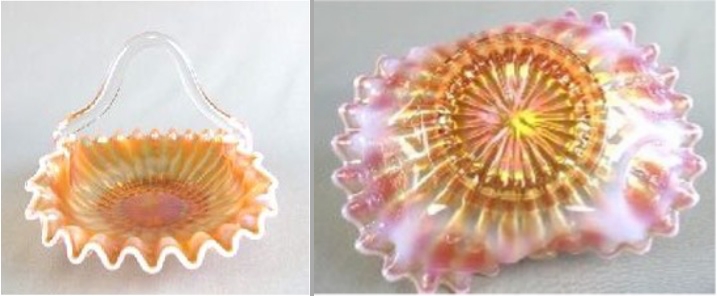
The Smooth Rays with Jeweled Heart exterior basket shows the interior and exterior. Photos courtesy of Steven Lindquist & Gary Sullivan.
Smooth Rays/Plain with Factory-Attached Handle
The basket with a Smooth Rays face and an unpatterned backside is, like the Smooth Rays/Jeweled Heart, a banana-shape bowl to which a clear crystal handle was attached during production. Its outer edge is smooth, neither serrated nor tightly crimped. There are 22 concave rays on its interior surface. Inside the collar base is a sunray. Its handle appears always to be an Inverted V shape, none currently known with rounded or looped handles.
The bowl is about six inches long and three and one- half inches wide at the point where the handle is attached. Its height from base to top of handle is five and one-half inches, two and one-half inches from base to the zenith of the container. Its base diameter is two inches. The outer edge of the collar base is ridged rather than smooth.
The Smooth Rays/Plain basket is rare, with only a couple having been reported. One is owned by Gary Sullivan and Steve Lindquist who bought it a few years back from Mike Soper at a Hagerstown, Maryland, carnival event. The other sold at a Burns Hagerstown auction in October 2019. There must be others yet to be accounted for.
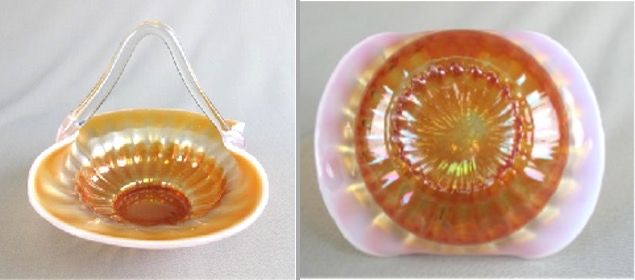
Steven Lindquist and Gary Sullivan also shared their Smooth Rays/Plain back basket with us.
On a related note, the Sheffields, from Kentucky, sold a Dugan Smooth Rays/Plain tightly crimped tri-cornered bowl on an online auction in September 2019. Dugan Smooth Rays/Plain bowls in any shape are markedly harder to find than the Smooth Rays/Jeweled Heart. Unlike most Smooth Rays/J.H. bowls, it appears to be a dark marigold rather than a light peach. One has to wonder if there might be Smooth Rays/Plain baskets with crimped edge, too.
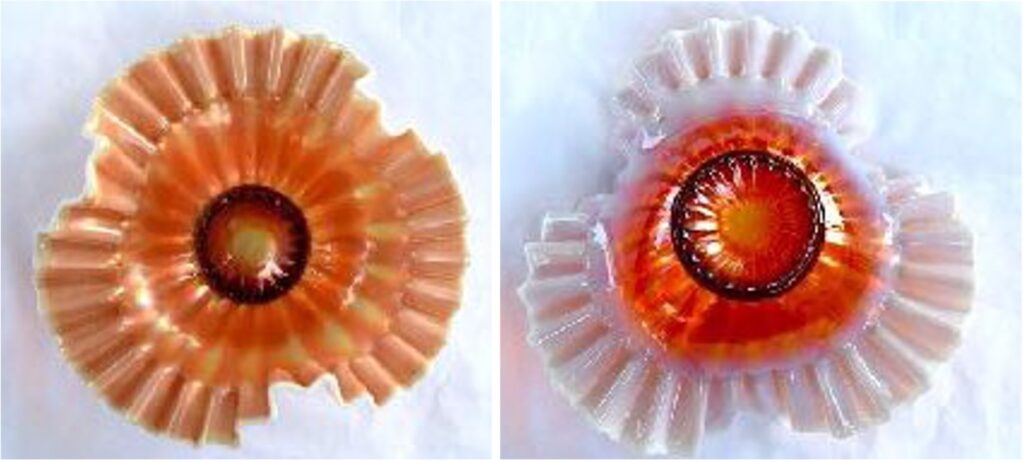
Scott and Susanne Sheffield provided the photos of a tri-corner Smooth Rays/ Plain exterior bowl.
Basket with a Smooth Rays/Jeweled Heart Bowl Set in a Metal Frame
On occasion a peach opal Smooth Rays/Jeweled Heart banana shape bowl set in a metal frame surface. This combination of elements is often called a bride’s basket. The bowl is configured in such a way that it fits tightly into the frame but is otherwise similar in dimensions to that of bowls to which clear crystal handles were affixed.
The bowl of the illustrated basket measures six and three-fourth inches from end to end and five inches at its waist. The girth of the basket’s bowl is greater than that of typical banana bowls, suggesting that it was formed to fit snugly in the holder and that not just any banana bowl will do. In frame, the basket stands six inches tall. It sold on an eBay auction several years ago.
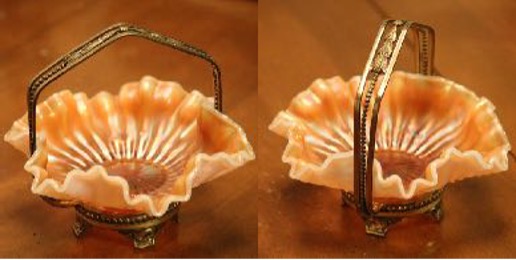
The Jeweled Heart bowl in a metal frame is shown above in two photos taken by Diane Highnam. The second one shows the beautiful metal work of the frame.
Other Dugan bowls set in metal frames—like large platform-base Caroline and dome-base Ski Star, mid-size Daisy Dear, and small deeply ruffled Fishscale and Beads and ruffled and tightly crimped banana-shape Petal and Fan/Jeweled Heart—are also available. Frames for baskets and condiment containers (the smallest of two-piece items of this type) were probably outsourced by the firm, not in-house produced. These baskets were marketed in limited quantities, likely as novelty or niche items, from roughly late 1910 through 1911.
Smooth Rays Mid-Size Baskets
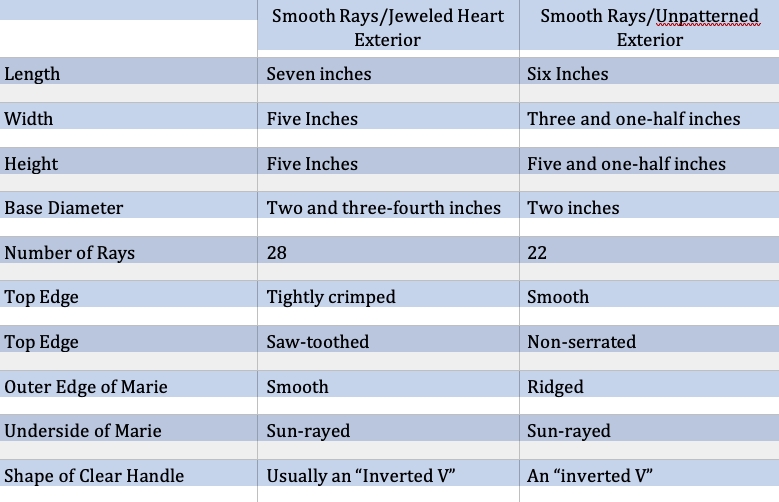
This article first appeared in the ICGA Pump in the March 2020 issue and is reprinted with permission.
